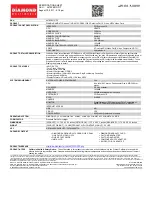
5-2
Calibration
KPCI-3110 and KPCI-3116 User’s Manual
Introduction
The KPCI-3110 and KPCI-3116 boards are calibrated at the factory and should not require
calibration for initial use. It is recommended that you check and, if necessary, readjust the
calibration of the analog I/O circuitry on the KPCI-3110 and KPCI-3116 boards every six
months.
NOTE
Ensure that you installed the DriverLINX software prior to using the
DriverLINX KPCI-3110 and KPCI-3116 Calibration Utility. Refer to
the DriverLINX Online Documentation for more information.
This section describes how to run the KPCI-3110 and KPCI-3116 DriverLINX Calibration Util-
ity and calibrate the analog I/O circuitry of the KPCI-3110 and KPCI-3116 boards.
Objectives
For analog inputs, the objective of this procedure is to zero the offsets and adjust the combined
gain of the A/D converter and instrumentation amplifier. For analog outputs, the objective is to
independently zero the offset and adjust the gain for each of the digital-to-analog converters
(DACs) on your KPCI-3110 or KPCI-3116 board.
Calibration summary
Analog inputs and outputs are calibrated using a DC calibrator, a DVM/DMM, and the Driver-
LINX Calibration Utility. (The DriverLINX Calibration Utility was installed on your computer
when you installed the DriverLINX software.) No calibration potentiometers must be adjusted.
No test points on the board are used. Only connections to the I/O connector pins, via a screw ter-
minal accessory, are needed.
Equipment
The following equipment is needed to calibrate your KPCI-3110 or KPCI-3116 board:
•
A digital voltmeter (DVM) or digital multimeter (DMM) accurate to 6
½
digits, such as a
Keithley Model 2000.
•
An STP-3110 screw terminal accessory to make analog connections to the board.
•
A Keithley CAB-307 cable to connect the screw terminal accessory to the connector of the
KPCI-3110 board.
•
A DC calibrator or precisely adjustable and metered power supply having up to a 10VDC
range and accurate to 6
½
digits.
Summary of Contents for KPCI-3110
Page 3: ......
Page 4: ......
Page 7: ......
Page 8: ......
Page 16: ...Preface...
Page 20: ...1 Overview...
Page 25: ...2 Functional Description...
Page 54: ......
Page 55: ......
Page 57: ......
Page 58: ......
Page 59: ......
Page 61: ...3 Installation and Configuration...
Page 66: ......
Page 68: ......
Page 80: ......
Page 81: ......
Page 82: ......
Page 83: ......
Page 84: ......
Page 85: ......
Page 86: ...4 Testing the Board...
Page 89: ...5 Calibration...
Page 92: ...6 Troubleshooting...
Page 99: ...A Specifications...
Page 111: ...B Connector Pin Assignments...
Page 116: ...C Systematic Problem Isolation...
Page 143: ...D Using Your Own Screw Terminal Panel...
Page 156: ......
















































